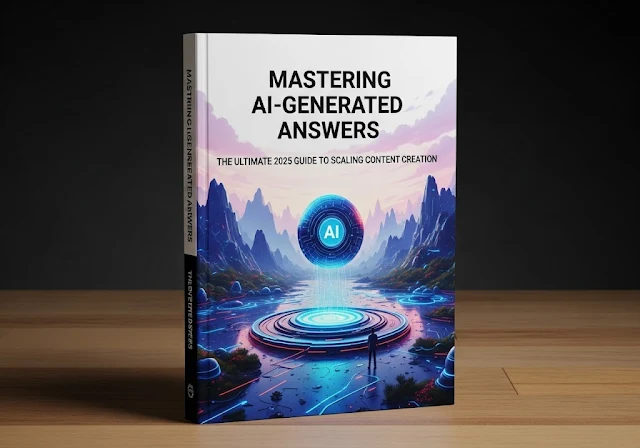Mastering AI-Generated Answers: The Ultimate 2025 Guide to Scaling Content Creation
Artificial intelligence now powers over 70% of digital marketing campaigns, with brands like The Washington Post and ClickUp reporting double-digit growth in efficiency and engagement after adopting AI-driven content strategies. But mastering AI-generated answers requires more than just using tools—it demands strategic integration, quality control, and human creativity.
This comprehensive guide outlines the essential steps, best practices, and real-world examples to help content creators maximize the impact of AI across industries.
 |
| Mastering AI-Generated Answers |
Understanding AI-Generated Content: Technology and Foundations
AI-generated content refers to text, images, videos, and other media produced by artificial intelligence models rather than humans. The core technologies powering AI content creation include:
Natural Language Processing (NLP): Enables AI systems to analyze, understand, and generate human language.
Machine Learning: Algorithms that can improve themselves and adapt based on new data without explicit programming.
Transformers: A type of neural network architecture especially adept at NLP tasks like language translation. Models like GPT-3 are built on transformers.
How Do AI Models Work?
AI content generation relies on models trained on massive datasets. By analyzing these examples, models learn linguistic patterns and how to remix ideas in novel combinations.
The quality of output depends heavily on prompt engineering - framing clear instructions and providing diverse, high-quality training data. With feedback and iterations, models continuously improve.
 |
| Understanding AI-Generated Content |
Key Abilities and Limitations
AI-generated content offers:
- Speed and scale: Produce more content faster, personalized at scale.
- Consistency: Maintain brand voice and quality standards.
But it lacks:
- Creative originality: AI remixes, rather than originates.
- Contextual awareness: Struggles with complex world knowledge and cultural nuance.
Real-World Examples
- The Washington Post's Heliograf AI generates basic news stories on subjects like sports game recaps.
- Toymaker Mattel uses AI image generation to explore new product designs based on text prompts.
- Grammarly's AI helps edit for conciseness, clarity, and quality control.
Integrating AI into the Content Creation Workflow
Successful adoption requires strategic integration focused on hybrid workflows and robust quality control:
 |
| Integrating AI into the Content Creation Workflow |
Workflow Integration Strategies
- Start with specific content types like social media posts or news briefs.
- Slowly scale up AI involvement as models improve.
- Maintain human creativity, editing, and oversight throughout.
The Hybrid Approach: AI + Humans
- AI rapidly generates draft content.
- Humans refine for tone, nuance, accuracy, and brand alignment.
- The best results come from complementary strengths.
Quality Control and Ethical Considerations
- Multi-layer review and editing to catch errors.
- Plagiarism checks using duplication detection software.
- Fact-checking important claims.
- Mitigate biases by diversifying data sources.
Real-World Examples
- Using Surfer SEO, ClickUp increased organic traffic 85% by scaling high-quality content.
- Forbes uses Quill to draft content then has human editors refine it.
- The AP's Automated Insights creates real-time news and financial reports.
Maximizing Impact: Best Practices, Challenges, and Future Trends
Mastering AI requires prompt engineering, performance monitoring, addressing limitations, and tracking emerging innovations.
 |
| Maximizing Impact: Best Practices, Challenges, and Future Trends |
Prompt Engineering for Better AI Answers
- Be specific with instructions to reduce ambiguity.
- Provide examples and templates to guide output.
- Iterate based on feedback to improve quality over time.
Performance Monitoring and Improvement
- A/B test AI vs. human-generated content.
- Analyze engagement, conversions, and SEO metrics.
- Address underperformance with further training.
Addressing Challenges: Ethics, Originality, and Context
- Mitigate bias by diversifying data sources and monitoring for issues.
- Maintain human oversight for culturally sensitive topics.
- Strengthen context with knowledge bases like Wikipedia.
- Disclose AI use for transparency.
Future Trends
- More personalized, interactive content experiences.
- Predictive analytics to optimize content strategies.
- Closer collaboration between AI tools and human creators.
Real-World Examples
- News agencies like AP and Reuters use AI for accurate, rapid reporting.
- HubSpot generates blog topic ideas using AI to keep content fresh.
- Adobe Sensei provides designers with creative suggestions to spark ideas.
Key Takeaways on Mastering AI-Generated Answers
AI-generated content can enhance efficiency, quality, and reach at scale—but only when combined with robust human oversight, prompt engineering, and strategic integration focused on complementary strengths.
Are you ready to reimagine your content creation process? Start by piloting AI tools in targeted workflow areas, honing prompt engineering skills, and developing a hybrid system optimized for both human creativity and AI capabilities. With a thoughtful, ethical approach, generative AI can transform how businesses develop and deliver digital content.
Frequently Asked Questions
Q: How accurate is AI-generated content?
A: It varies based on training data quality and prompt engineering. AI can excel at basic factual reporting but still struggles with nuanced takes requiring deeper analysis or cultural knowledge. Extensive human editing and fact-checking is critical to ensure accuracy.
Q: Is AI-generated content original?
A: AI models actually remix and repurpose existing ideas rather than originate new ones. Content may be new but often lacks true creativity. Ensuring originality requires checking for plagiarism and investing in high-quality training data.
Q: How do you improve AI content over time?
A: The key is iteratively honing prompts with clear instructions, diverse examples, and feedback on what works. Monitoring performance metrics also helps identify areas needing improvement through further training.
Q: What ethical concerns exist around AI content?
A: Potential issues include plagiarism, inaccuracies, offensive output, and perpetuating harmful biases. Mitigation requires extensive human oversight, diversity in data/teams, transparency, and bias testing.
Q: What's the future of AI content tools?
A: Expect even more human-like output, personalized content at scale, tighter creative collaboration between humans and AI, and predictive analytics optimizing entire content strategies. But responsible human guidance will remain essential.






